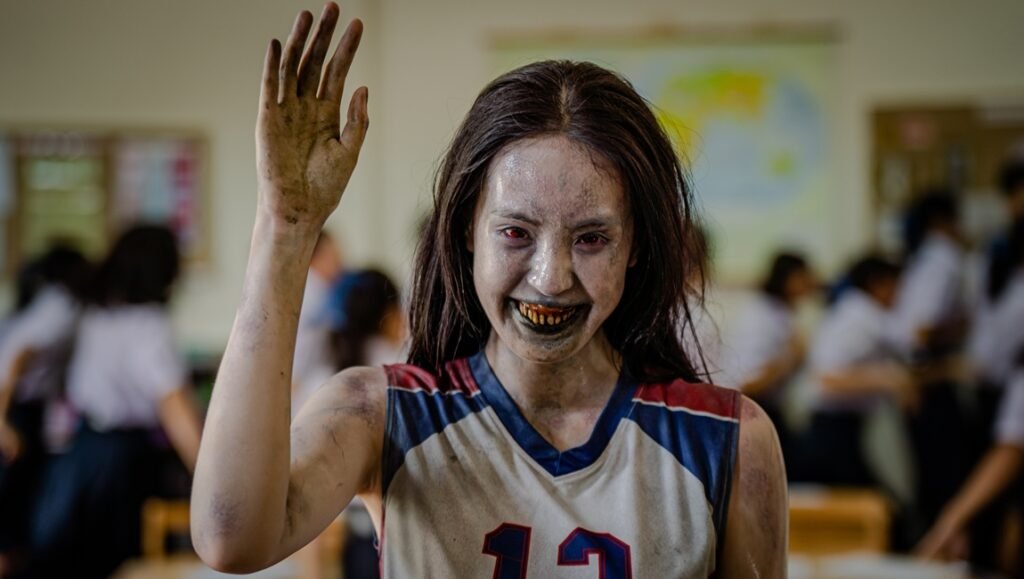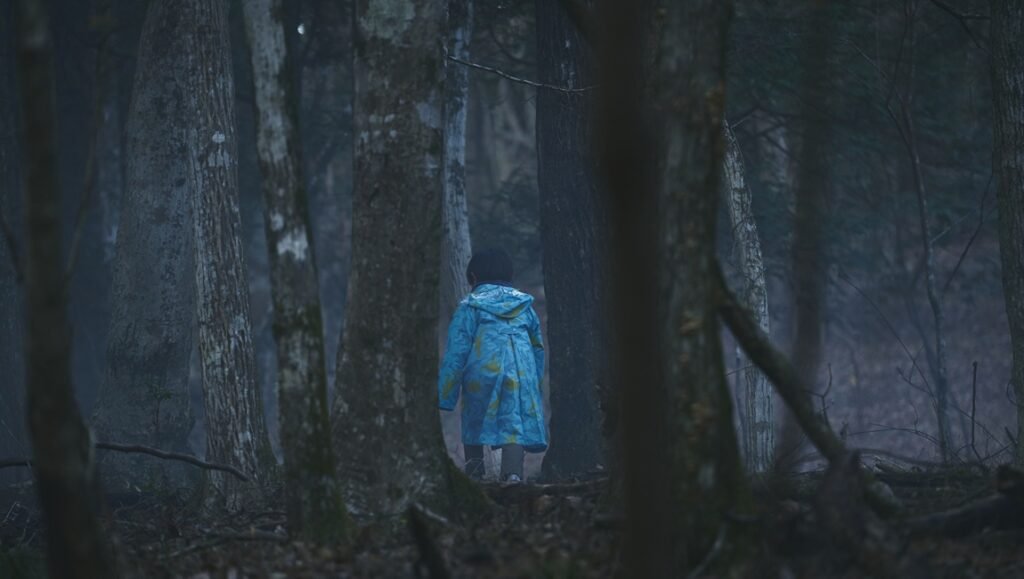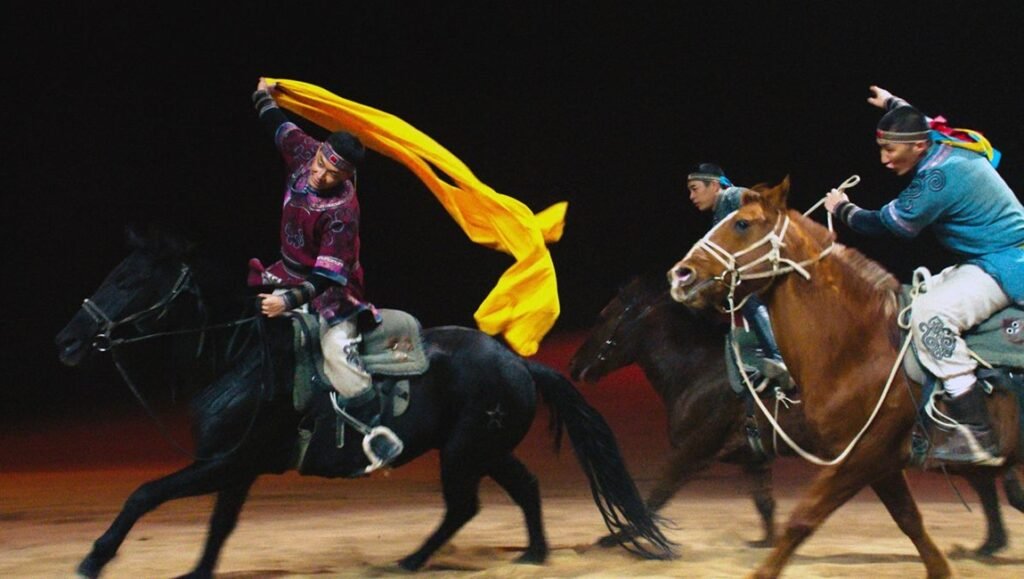Queerpanorama
Writer-director Jun Li received a degree in journalism from the Chinese University of Hong Kong, and in his self-referential film Queerpanorama, the journalistic impulse is embedded in its very conception. Jayden Cheung plays the protagonist, a solitary gay man living in Hong Kong who structures his life around sex. He meets most of his partners on hookup apps, and most are expats (some snarkily refer to him as a “local”). He peppers each of his partners with questions about their lives, and at each new encounter, he takes on the name and profession of the last man he had sex with. Li modeled the film on his own sex life, noting in an interview that Queerpanorama is “very much autobiographical. The inspiration happened when I was getting penetrated. It just came to me while I was having sex and I thought, ‘Oh, that would be a good idea!’” The men that Cheung’s character has sex with, accordingly, are based on some of Li’s own past sexual partners, and many are non-professional actors playing themselves. Shot in crisp, evocative black-and-white by director of photography Yuk Fai Ho, Queerpanorama is as aesthetically appealing as it is sexually forthright, but the film is undercut by its muted tone and inherently insular nature.
While the episodic structure of Queerpanorama precludes a traditional character arc for its unnamed protagonist — the “real” name of this character who tries on a multitude of identities is never revealed — Li does slowly unfurl his initially inscrutable protagonist’s state of mind with each new scene. He is intellectually curious and artistically inclined, but also struggles with depressive episodes, telling one partner that he took up smoking after reading a warning on a package that cigarettes “kill you slowly.” For Cheung’s character, sex takes on many roles in his life beyond momentary pleasure: it’s a form of casual social contact, of temporary escape from his own unsettled identity, and, possibly, a source of deeper interpersonal connection.
The actors playing the one-night stands give performances of varied effectiveness, as is to be expected from an ensemble consisting of both professionals and non-actors playing themselves. The naturalistic, often lengthy scenes include extensive small talk, and Li and his actors never quite manage to make these awkward minutiae of pre- and post-coital interactions cinematically compelling. Some of the desultory conversations do reach more provocative places, particularly when domestic and global politics filter into the lovers’ discourse. The repressive political environment of Hong Kong and the lingering effects of the 2019 pro-democracy protests subtly inflect the film, and through the many conversations onscreen held between men of different nationalities, Li thoughtfully probes the relative nature of personal and political freedom within this complex sociopolitical environment. Take, for example, a pithy observation made by a Taiwanese flight attendant, who has recently broken up with a long-term boyfriend rather than move with him to the UK: “When I am in Europe, I always wonder how much they care about human rights when you have to pay to use the toilet.”
Elsewhere, Li shoots Queerpanorama‘s sex scenes with frank clarity. He neither downplays nor sensationalizes sex; sex acts involving poppers, lingerie, and dildoes that might be depicted as cheaply titillating by other filmmakers are treated as casually by Li as platonic cuddling. Li’s approach to sex on film, however, veers a touch too close to being overly distanced. Most of the sex scenes take place in a frame within a frame: within the already-compressed Academy ratio the film is shot in, doorways and walls often close in on sex acts that tend to occur deep in the frame. These multiple distancing devices lend an impersonal, near-clinical tone, and in combination with the protagonist’s own emotional remove, the viewer is placed a few degrees too far outside of the situation to fully engage. Li’s overly distanced approach to Queerpanorama’s sexuality is symptomatic of a larger issue with the film: the circular sexual odyssey Li depicts is ultimately too inwardly focused, keeping the viewer at arm’s length not only from the sexual acts themselves, but from the development of his protagonist’s interiority. The array of queer men depicted in Li’s film is indeed panoramic, but Li struggles to fully pair the external variety with internal depth. — ROBERT STINNER

Attack 13
Taweewat Wantha’s Attack 13 is unabashedly commercial entertainment — a horror movie made with the kind of cleanness, galloping pace, and pulsing score typical of much contemporary action cinema. However, within its mainstream parameters, it finds openings for some genuinely nasty imagery and social observation, and it creatively crossbreeds high school melodrama and supernatural horror conventions.
The film begins with Jinhandra’s (Korranid Laosubinprasoet) arrival into a histrionically Darwinist high school. Bussaba (Nichapalak Thongkham) rules the campus like a Mafia don, subjecting her peers to a range of violent humiliations (everything from extortion and locker room water torture to the forced removal of dog waste from her shoe). Conflict escalates when Jinhandra challenges Bussaba’s supremacy, and a series of circumstances lead to Bussaba’s suicide by hanging in the school gym. An unknown shaman resurrects Bussaba, and her revenant spirit begins tormenting Jinhandra and her friends. Mystery accumulates as the film charges through various scenes of supernatural attack: who summoned Bussaba’s spirit, and why? Will Jinhandra and her friends banish Bussaba back to the grave before she has claimed all their lives?
Attack 13’s most compelling features stem from thematic collisions — between past and present, physical and metaphysical, and the shifting roles between subordinator and subordinated. It juxtaposes the imagery of ancient shamanic magic with contemporary adolescent life, opening with an arcane forest ritual replete with squirming insects and reptiles before cutting to a school gymnasium volleyball match. Bussaba’s predatory, incorporeal specter attacks with decidedly corporeal gusto, puncturing eyeballs and smashing faces into mirrors with cruel abandon.
Despite its grotesquerie, the film’s shamelessly familiar genre trappings and liberal use of CGI sometimes engender a curiously distancing, weightless quality. More often, however, the film uses its digital effects to create inventively macabre images of spectral malevolence and mutilation. Its sleek, digital aesthetic is consistent with its contemporary settings, and with its concerns surrounding public image and online selfhood (key plot points hinge on text conversations, iPad passwords, and selfie exchanges.)
There’s plenty to admire in Attack 13. The third act veers into pleasantly surprising territory with several unexpected deaths and plot revelations. Laosubinprasoet, for her part, boasts the screen presence and instincts of a natural movie star. Director Wantha intelligently stages his stalk-and-kill sequences in various settings: locked cars and urban streets, dorm rooms and childhood homes. It eventually upends the Manichean morality of its first act, exploring power as something relational and ever-shifting rather than monolithic. — MIKE THORN
To Kill a Mongolian Horse
The sands of time are unerring in their flow, which is another way of saying that if the desert is your home, time leaves few traces of you behind when you die. There is a curious ambivalence to this image, presented plaintively and plainly in Jiang Xiaoxuan’s debut feature, To Kill a Mongolian Horse. Stretching across the barren and defiant steppes of Inner Mongolia, Jiang’s elegy to the herders and horseriders of the region laments not just a lost tradition, which has been encroached on by forces impervious to its staid rhythms, but also the unchanging landscapes that constitute a tale of ceaseless violence and disarray. “Will the grasslands care if people like us live or die?” a beggar asks of Saina, a horseman played by the production manager of Jiang’s 2022 short, Graveyard of Horses. Their way of life, past and present, is a hard one.
And yet the indomitable spirit of the human will rears its head, even if in somber desperation; for To Kill a Mongolian Horse requires less of awe and wonder than it does the stoic plodding of hooves onward. Its thematic concerns are heavy and sometimes obvious, perhaps the result of a filmmaker admirably working within the confines of China’s censorship to bring to life the joys and travails of its ethnic minorities. In Saina’s case, two polar worlds threaten to deprive him of a proper life in either: his homestead bears little fruit in the face of perennial drought, while calls to join an exodus into city life — most prominently by his ex-wife Tana (Qilemuge) — inevitably sputter under a realization that the city does not belong in him. Saina’s father (Tonggalag), having accrued significant gambling debts and an alcohol dependency, sells some of their sheep, while he and an old friend, Hasa (Undus), race part-time at a circus fair, determined to perform the pride and heritage of the Mongols for the Chinese tourists that patronize them.
Jiang’s portrait of a horseman as performer evocatively fleshes out the struggle for identity, against the modernizing hand of capitalist relations no less, but foremost in the performance and preservation of a premodern masculinity. This masculinity, taking flight amid the tent flaps of the fair and shot by cinematographer Tao Kio Qiu in shades of red and haunting, cerulean blue, is an obvious simulacrum, catering to foreign eyes and staving off at best the fear of cultural extinction. But it also recalls what Christopher Beckwith termed the “nonexistence of barbarians” in Central Asia and the steppes of Inner Mongolia: these mythic warriors and savages never arrived, for they were, since the inhabitation of the land, always there. And neither have they left. The horse, a metonym for its rider, gallops across the steppes, whose barrenness “reveals buried bones” from which “an endless bondage then takes seed.” To Kill a Mongolian Horse underscores, perhaps unintentionally, the cunning of this device. In the region’s thousand-year saga of survival, time is the greatest and only killer. — MORRIS YANG

Ryota Kondo’s debut feature, Missing Child Videotape, begins 13 years following the disappearance of the protagonist, Keita’s (Rairu Sugita) younger brother, Hinata. When Keita’s mother mails him a videotape documenting the incidents surrounding Hinata’s vanishing, a long-dormant mystery reemerges like a resurrected corpse. Keita watches the eerie tape with his spiritual clairvoyant roommate, Tsukasa (Amon Hirai), who — unbeknownst to Keita — soon begins reluctantly discussing the case with a reporter named Mikoto (Kokoro Morita).
The mysterious videotape showcases the film’s first indication of Kondo’s directorial attentiveness; rather than doctoring high-resolution digital footage in postproduction, as far too many contemporary directors are wont to do, Kondo shoots the tape sequence in the correct format and aspect ratio. This attention to textural detail imbues the scenes with mimetic verisimilitude, a necessary sense of the past intruding on the present. The tape shows Keita and Hinata playing hide-and-seek on the forested Mount Mashiro, where they stumble upon a decrepit institutional building, which Hinata playfully claims is full of “puyo puyo” (a Japanese onomatopoeia representing the movement of soft objects, and also the title of a popular Japanese puzzle video game). Keita finds Hinata hiding in a murky hallway before the boy silently glides offscreen, never to be seen again.
Missing Child Videotape’s most significant virtues are in the intricacies of its folklore-steeped plot, which patiently unfolds with carefully administered moments of eerie revelation, especially surrounding the site of its central mystery. We learn that police never discovered the building where Hinata disappeared, and that an unusual concentration of mysterious disappearances and deaths have occurred on Mount Mashiro. During her investigation into Hinata’s disappearance, Mikoto obtains an audiocassette documenting a missing university mountaineering club also stumbling upon a ghostly building on Mashiro. In thematic and structural terms, the story abstractly recalls the likes of The Stone Tape (1972), written by Nigel Kneale. The film is bookended by sequences featuring an eerie bell that jingles in the misty Mashiro forest, evoking classic ghost stories like M. R. James’s “Oh, Whistle, and I’ll Come to You, My Lad” and the silent horror classic The Bells (1926).
Missing Child Videotape is an impressive debut feature, well-steeped in the tradition of late ‘90s to early ‘00s golden age “J-horror” — a cinematic cycle replete with metaphysical viruses, haunted recordings, and dreadful unknowing. It would be unfair to hold Kondo to the standard of the great Kiyoshi Kurosawa — or even Takashi Shimizu, Hideo Nakata, or Koji Shiraishi — but he shows himself to be a serious and thoughtful observer of quiet horror, scrupulously invested in story architecture, sound design, and the dynamics of visual space. The film contains many indicators of an attentive cinematic craftsperson — Kondo uses an almost invisibly slow zoom for a one-take exposition monologue scene to unnerving effect; he syncs the mountaineering club’s disappearance audio-recording to Keita’s climactic, frightening nighttime ascent. Kondo’s directorial style is intelligently presentational, showcasing an aptitude for visual simplicity through understated camera direction and deliberate editing. Missing Child Videotape might not achieve the levels of overpowering terror promised by its premise, but it announces the emergence of a new filmmaker with serious potential. — MIKE THORN


Comments are closed.